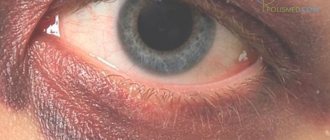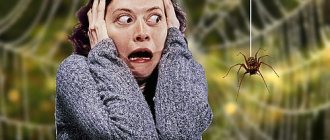Definition of acrophobia
Acrophobia is the fear of heights. The word comes from the Greek language. Akros means upper, and phobos means fear. Doctors do not consider this condition a serious illness because, in their opinion, it does not affect a person’s quality of life. Other phobias, such as fear of open areas and crowds of people, are considered more dangerous. Because of them, people find themselves imprisoned in their own home. They are unable to work normally or perform simple activities, such as going to the store for purchases.
With acrophobia the situation is simpler. Skydiving or climbing mountains are not vital activities. Fear of heights deprives a person of only some entertainment. These include hot air balloon rides, rides on cable cars, slides in a water park, etc. In addition, he will not be able to live on the upper floors.
Despite all this, fear of heights is much more serious than it seems. This is evidence that a person’s nervous system is impaired and there is also a risk of developing mental disorders.
Interesting! About 5% of the world's population suffers from acrophobia.
What is acrophobia
Fear of heights that has developed into a phobia is called acrophobia; it is one of the most common fears, affecting almost 10% of the population (4% of women and approximately 5% of men). Every tenth is a lot.
This phobia must be fought, because over time it intensifies; in older people, in addition to the fear of falling, the seemingly normal fear of fractures is added. Over time, a “fear of fear” may arise, when we begin to increasingly avoid what we are afraid of; over time, life can become completely unbearable, relationships with loved ones will deteriorate, it will become impossible to work and even leave the house, go down the stairs to the street. It happens that such panic also sets in when the acrophobe himself stands firmly on the ground and sees someone who is at a height (a neighbor on the balcony, a cat on the roof, etc.). Then the person imagines himself in their place and is afraid of falling. This fear can make life completely unbearable, turning it literally into one huge self-restraint and lack of freedom.
Types of acrophobia
There are several types of phobias associated with fear of heights:
- aerophobia - fear of flying;
- bathophobia - fear of sudden changes in depth or height;
- Illingophobia is the fear of feeling dizzy at altitude.
There is also climacophobia - the fear of climbing stairs.
Causes of the disease
Scientists have different opinions about the causes of acrophobia:
- The main theory is somatic pathology. It lies in the fact that the work of the vestibular apparatus, which regulates balance, is disrupted in the body, and the person begins to feel severe fear at high altitudes.
- Some believe that fear of heights is caused by negative experiences acquired in childhood and a person’s rich imagination, which is able to imagine in all colors all the consequences of falling from a height. This theory is not entirely justified, since many people have not had a negative experience in life, but despite this, they begin to have a panic attack on the edge of a steep cliff.
Carrying out numerous experiments, scientists have proven that fear of heights is inherent not only in intelligent beings, but also in animals that are able to see the space around them.
Acrophobia and natural fear of heights - differences
There is hardly a person who will not experience discomfort while being on the edge of a high cliff or riding a Ferris wheel. And that's okay. If such feelings did not exist, people would die out due to reckless actions. But thanks to natural fear, you will step back from the edge of the roof of a high-rise building or the same cliff, so as not to fall from a height. In this case, you will not experience any unpleasant mental or physical symptoms.
With acrophobia things are different. Fear of heights seems to paralyze a person’s consciousness, depriving him of the ability to make adequate decisions or, for example, to escape from danger. Over time, fear intensifies. Discomfort appears at low, non-hazardous heights. Some people are even afraid to stand on a chair.
The second characteristic feature of acrophobia is an attempt to avoid situations in which unpleasant emotions may appear. An ordinary person will behave calmly if he is on a hill, riding in an elevator, or standing on a balcony on the upper floors. Those who have a fear of heights avoid such places.
Acrophobia lives in the subconscious, and it is completely illogical. A person cannot analyze the situation and understand that there is no danger for him. He does not realize that in order to fall he needs to take a step forward, and in order to avoid it he needs to step back. He's just terrified.
Fear of heights acrophobia: causes and treatment
Most people experience discomfort when climbing to unusual heights. But only for some these sensations become particularly acute, expressed in attacks of nausea, dizziness, increased heart rate and other unpleasant symptoms.
These people suffer from acrophobia - this is the medical name given to excessive fear of heights.
Acrophobia is considered a mild neurosis and is not a disease that can subsequently seriously affect a person’s psychological state. Nevertheless, experts do not deny the possibility that this phobia is just one of the symptoms of more serious mental disorders.
Causes of fear of heights
Acrophobia can be congenital or acquired as a result of experiences of stress associated with heights. At the same time, an innate fear of heights is often accompanied by an aversion to noise and harsh sounds.
Scientists also concluded that acrophobia is characteristic of creative people with a good imagination. In such people, symptoms may occur only with the mere thought of getting up, as well as during sleep.
Scientists have not reached a consensus on the causes of fear of heights. The role of external factors is seriously questioned due to the presence of a congenital form.
Some experts consider the theory that the nature of this phobia has deeper roots and is associated with the fears of ancient man and his overdeveloped instinct of self-preservation to be more substantiated. The argument in favor of this version is the fact that fear of heights is characteristic not only of humans, but also of any animal that can see.
Another suspected cause of this phobia may be a dysfunction of the vestibular apparatus.
Symptoms
Fear of heights can be expressed differently in different people, but based on surveys of people suffering from it, the most common symptoms can be listed:
- loss of self-control;
- desire to jump in the absence of suicidal tendencies;
- dizziness accompanied by attacks of nausea or vomiting;
- dysfunctions of the gastrointestinal tract, expressed, in particular, in the form of diarrhea;
- change in heart rate - tachycardia or bradycardia;
- increased sweating;
- tremors of the limbs and uncontrolled movements.
In case of obsessive phobia, the symptoms of which can be expressed daily and regardless of location, it is strongly recommended to immediately consult a specialist in order to avoid the development of more serious mental disorders.
At the same time, fear that arises in close proximity to an abyss is a normal phenomenon, characteristic of any person.
Acrophobia treatment
According to experts, it is impossible to cure acrophobia on your own, especially in cases where its manifestations are systematic and pronounced.
For those with acute acrophobia, treatment should be carried out by qualified and experienced professionals, with a clear diagnosis based on the patient's testimony and the results of functional tests.
Constant stress associated with experienced fear can lead to depression and premature wear and tear of the cardiovascular and nervous system.
Drug treatment may provide temporary relief or help you complete a planned activity, such as flying. But to achieve lasting results, it is necessary to use psychotherapeutic methods.
In addition, a specialist can recommend various techniques and exercises for independent work. With systematic implementation and a certain degree of determination, they will allow you to cope with your fears, and over time, completely get rid of them.
Causes
It is impossible to say unequivocally what provokes the development of acrophobia. Psychiatrists and psychologists have not yet reached a consensus on this issue. But several reasons were still identified.
Innate fear
Scientists have proven that fear of heights is genetic. To do this, they conducted an interesting study. The floor surface was divided into two parts. The first one was made transparent. The second one was no different from the usual sex. They created the illusion of emptiness from below. Not a single child participating in the experiment wanted to stand on a transparent surface, even in cases where his parents persuaded him to do so.
Brain disorders
They occur after a person has had a viral or infectious disease. Risk factors also include excessive consumption of alcoholic beverages, narcotic and psychotropic substances.
Special personality constitution
There are people with increased sensitivity to everything that happens around them. They react sharply to any event, experience discomfort in bright lights, loud sounds, or the need to be near other people for a long time. They don't watch scenes of violence in films and are afraid of blood. There are about 10% of these on the planet.
A highly sensitive nervous system is one of the reasons for the development of acrophobia.
Traumatic situations from the past
Perhaps someone experienced stress associated with heights in early childhood. Often a person no longer remembers under what circumstances everything happened. But this information is imprinted in his subconscious.
Balance problems
The last reason that provokes the development of acrophobia is disturbances in the functioning of the vestibular apparatus.
Causes of acrophobia
Previously, it was thought that the causes of such fear were a weak vestibular apparatus or early trauma associated with a fall or fear of heights. It has now been proven that this is almost exclusively a genetically determined and innate quality , and may not be related to the vestibular apparatus. The balance of the body is achieved thanks to the coordinated precise work of the vestibular apparatus, eyes, nerve pathways, midbrain, and cerebellum. When there are discrepancies or delays, asynchrony of the signals “I see” and “I feel,” conflicting information enters the brain, hence the failures. If at the same time the muscles respond with an incorrect delay, then the balance system is completely disrupted.
Symptoms of acrophobia
Fear of heights manifests itself in two types of symptoms: somatic and mental.
Somatic
A person faces the following signs of pathology:
- shortness of breath at rest;
- tachycardia;
- dizziness;
- pale skin;
- nervous trembling;
- lump in throat;
- feeling of tightness in the chest, pain;
- excessive sweating;
- feeling of dry mouth;
- nausea;
- stomach upset;
- frequent urge to urinate;
- insomnia, long time falling asleep;
- waking up too early;
- nightmares, restless sleep.
When encountering the listed symptoms, many patients do not think at all that these are manifestations of acrophobia. Therefore, they go to the wrong doctors, undergo a bunch of examinations, but still cannot get the right treatment. As a result, the phobia intensifies, causing the development of other disorders or fears.
Mental
Mental symptoms include:
- excessive fussiness, haste;
- irritability, anger;
- aggressiveness;
- excessive stress;
- severe anxiety;
- constantly thinking about what might happen, such as falling;
- anxiety, bad feelings;
- problems with concentration;
- "empty head.
When fear reaches its peak, the patient's condition worsens. Due to spasm of blood vessels, dizziness appears, fainting, and loss of contact with reality are possible.
People who have more mental symptoms than physical symptoms are highly focused on their feelings and experiences. They often become depressed and refuse treatment, not believing in its effectiveness. Due to excessive suspiciousness, they are afraid of the side effects of medications prescribed by a doctor. Trying to avoid them, carefully read the annotations to them.
Causes of acrophobia
Experts divide the causes of fear of heights into two large groups: psychological and physiological. Psychological factors include:
- low self-esteem in childhood due to strict upbringing, lack of love, tenderness and affection from parents;
- high level of personal anxiety, emotionality, self-doubt;
- rich imagination and high impressionability; in such people, fear can manifest itself even in a dream or simply from the thought and imagination of falling.
Physiological reasons:
- disruption of brain function after injury and illness;
- heredity features (presence of close relatives with mental disorders);
- experiences and psychotraumas;
- alcoholism with constant poisoning;
- disturbances in the functioning of the vestibular apparatus.
A type of acrophobia is the fear of losing control and stepping down, which appears in a person at high altitudes, fear of flying on airplanes (aerophobia), fear of dizziness (illingophobia), fear of falling down the stairs (climacophobia).
Pathological fear appears, according to psychologists, due to severe stress. But in relation to the fear of heights, the reason is somewhat different. It is based on the instinct of self-preservation, since this is a natural reaction of the body that prevents a person from dying when falling. But it turns on the patient at the wrong time when necessary, even if he is completely safe. Many experts believe that acrophobia develops not so much from being on a hill, but is the result of imagination, when a person imagines himself falling and dying, or being injured.
For many patients, fear stems from childhood, when they fell heavily or were accidentally dropped by adults. The negative experience of this situation is stored in the subconscious and, under certain circumstances, comes to the surface. At the same time, most people do not remember what happened to them in the distant past.
Acrophobia in a child
In children, acrophobia can be congenital or acquired. In the second case, it develops if the child was dropped or he himself fell from a height. Sometimes fear is a consequence of overprotection on the part of parents.
Symptoms of the pathology are the same as in adults. Even at a low altitude, for example, in a high chair, the child experiences tachycardia, dizziness, and nausea. Sometimes body temperature rises.
It is easier for adults to control the negative emotions that arise in them. And it’s not always possible to do this. Imagine how much more difficult it is for a child whose psyche is still in the formative stage. In a panic, he cannot decide what to do next: stay in place or go down.
Manifestation of acrophobia in children
In children, acrophobia can be either congenital or a consequence of the child being dropped or falling on his own. Sometimes the fear of heights in children is provoked by the parents themselves through excessive care.
The child experiences significant discomfort even when he is on a slight elevation - a stool, a high chair. Like an adult in a state of panic attack, a child's heart rate increases, he becomes dizzy, feels nauseous, and has a fever.
If an adult with acrophobia cannot control his emotions, then what can we say about a child whose psyche is just developing. Panic does not allow the child to make a decision about how to protect himself and get down from the hill.
To develop an adequate response to heights in a child and stabilize the functioning of the vestibular apparatus, any jumping (on a trampoline, jump rope), riding bicycles and scooters, climbing ropes and children's sports ladders are very helpful. Such activities should be encouraged.
If your child has had a negative experience of falling from a hill and has already developed fear, then you need to gently explain to him that nothing terrible happened and there is no need to be afraid of possible falls. A good educational example would be cartoons and children's programs in which characters overcome similar fears.
The benefits and harms of fear of heights
Acrophobia brings both benefits and harm. Psychologists consider it a strengthened instinct of self-preservation, which prevents a person from thoughtlessly risking his health or life. He will never jump with a parachute, walk across a narrow bridge over an abyss, or ride dangerous rides. Such people do not have a craving for extreme sports. They don't need adrenaline. And this is a big plus. According to statistics, they are less likely than others to be injured due to falls.
The harm of fear of heights is expressed in the development of the above somatic and mental symptoms. No matter how hard a person tries to protect himself, sometimes he still has to deal with heights. At such moments he feels a lot of tension. His heart works overtime, and his blood vessels simply do not have time to respond to the rapidly changing volume of blood. As a result, blood pressure rises and stress develops. This leads to exhaustion, deterioration of immunity, and increased susceptibility to various diseases.
Symptoms of acrophobia
Symptoms of pathological fear are conventionally divided into two groups: mental and somatic.
Physiological or somatic signs
Somatic symptoms include the following:
- shortness of breath in the absence of physical activity,
- rapid heartbeat;
- dizziness;
- nervous trembling;
- "lump in the throat;
- pressure and pain in the chest;
- increased sweating;
- wet, cold hands;
- dry mouth;
- feeling of nausea;
- diarrhea;
- frequent urination;
- insomnia;
- nightmares.
Often it is the physical signs that patients perceive incorrectly, and they are sent to specialists in various fields, but not to psychiatrists. The patient is inclined to go to any expensive hospitals, being declared healthy in government institutions.
After all hospitals have confirmed the patient's good health, he begins self-medication, which further worsens the condition, increasing the feeling of fear, negatively affecting the personality and leading to additional phobias.
Mental symptoms
Mental signs of acrophobia are represented by the following symptoms:
- vanity, lack of patience;
- anger, aggression, high irritability;
- “compressed spring” state;
- severe anxiety;
- constant mental repetition of unpleasant situations;
- negative feeling;
- feeling of “emptiness” in the head;
- loss of attention.
At the peak of its formation, a panic attack leads to vasoconstriction, fainting and severe dizziness. Some patients do not perceive what is happening as reality, and there is a strong feeling of fear of going crazy.
The physical and mental symptoms of anxiety are correlated individually, so each patient’s illness progresses according to its own scenario. If mental symptoms outweigh, the patient begins to focus on his own feelings, which leads to depressive states.
Such people at the first stage of treatment are suspicious and do not believe in a positive result, they are afraid of side effects of drugs and carefully study their annotations.
To confirm the presence of acrophobia, a clear differentiation of disorders and anankasms that developed against the background of rigidity and pedantry is required. It is necessary to differentiate from an organic disorder accompanied by anxiety, for example, cardiovascular, pulmonary, neurological, endocrine, etc.
How to get rid of acrophobia
As with other phobias, the first step is to recognize the fear. And only after that start treatment. It is important that it be comprehensive.
Drug therapy
With the help of medications, you can at least temporarily muffle the symptoms. Most often, the doctor prescribes antidepressants, betaine inhibitors or benzodiazepines. They help cope with stress, relieve anxiety, and calm down.
But remember that medications do not eliminate acrophobia, since the cause of its occurrence is hidden deep in the subconscious.
Psychotherapy
A psychotherapist will help you find the root of the problem and eliminate acrophobia. Several methods have proven to be the most effective:
- Cognitive behavioral therapy. A psychotherapist will help you create attitudes aimed at combating the fear of heights, and will also teach you how to relax.
- System arrangements. This technique involves putting the patient into a semi-trance state. At this moment, a change in his attitude towards the phobia occurs.
- Hypnosis. The person falls into a state of suggestibility, during which the hypnotherapist corrects his behavior.
- Desensitization. Special exercises are used to combat acrophobia.
- Moreno method or psychodrama. The psychologist and the patient role-play possible dangerous and traumatic situations.
In some cases, body-oriented therapy is performed. It is aimed at studying the unconscious behavior of an individual, as well as the correct use of psychological defense methods.
Independent work
In addition to taking medication and working with a therapist or psychologist, it is recommended to follow a number of simple tips:
- Don't try to overcome acrophobia in one day; get used to heights gradually. First, rise to the level at which minor discomfort appears. Listen to yourself. Reassure yourself that you are safe. Then go to the next level. And so on until you overcome fear. If possible, let a person you trust be with you at these moments.
- Do some visualization. Imagine that you are a fearless person who is not afraid to jump with a parachute or climb to the roof of a high-rise building. Do this exercise every day. Remember that thoughts are material.
- Face your fear of heights head on. For example, go out to the balcony and do meditation there. Go with your friends to a high observation deck. If you're afraid of dizziness, just don't look down at first.
- Sign up for the pool. Learn to jump into the water from a low height and under the supervision of a trainer.
- Don't hide from tall buildings. Visit friends and relatives who live on the upper floors.
Under no circumstances should you close yourself off. Talk about your fears, discuss them with people. Perhaps they too have encountered such problems. This will make it easier for you to cope with acrophobia.
What to do if your child has acrophobia
Preventing the development of acrophobia in children is easier than curing it. Therefore, try to get rid of overprotection. If your child wants to climb a tree, ladder or rope, don't stop him. Just control the process.
If your child is already afraid of heights, use the method of therapeutic fairy tales. Let the hero be brave and courageous, conquer mountain peaks without fear, fly on an airplane or jump with a parachute. Talk about it in a confident voice.
You can also simulate a situation in which the child will be a rescuer rushing to help someone. For clarity, lift your baby’s favorite toy to the top shelf.
Remember that the child’s psyche has not yet formed. This means that his behavior can be corrected. Properly selected methods will help either prevent the development of acrophobia or reduce its impact on life. If you cannot overcome it on your own, contact a specialist.
Acrophobia in children
Children have the hardest time getting over their fear of heights. If a child falls from a height or is dropped, the child’s immature psyche reacts with pathological strong fear for a long time. Children develop panic, faintness, heart palpitations, nausea, and dizziness. The whole horror of the situation is that the baby does not control his actions, is not able to understand how to get down and be safe.
If treatment is not received in time or parents begin to overprotect the child, acrophobia develops. A qualified doctor can advise parents on how to help their child overcome his fear of heights.
Riding bicycles together, jumping on a trampoline, jumping rope, climbing gymnastic ladders, and ropes strengthen children's vestibular apparatus and help them overcome fear.
It is unacceptable to instill in a child that such activities are dangerous. In this case, the horror of heights will intensify. Children who have not experienced psychological trauma as a result of a fall should not cultivate thoughts about the dangers of heights and the fear of falling. They are subconsciously careful, this is confirmed by research by child psychologists.











